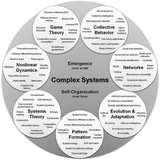💻 A comprehensive simulation on the #Ising_Model by Asher Preska Steinberg, Michael Kosowsky, and Seth Fraden, Physics Department, Brandeis University
🔑 The goal of this experiment was to create #Monte_Carlo simulations of the 1D and 2D #Ising model.
To accomplish this the #Metropolis algorithm was implemented in #MATLAB. The dependence of #magnetization on #temperature with and without an external field was calculated, as well as the dependence of the #energy, #specific_heat, and #magnetic_susceptibility on temperature. The results of the 2D simulation were compared to the #Onsager solution.
🔗 http://fraden.brandeis.edu/courses/phys39/simulations/AsherIsingModelReport.pdf
🔑 The goal of this experiment was to create #Monte_Carlo simulations of the 1D and 2D #Ising model.
To accomplish this the #Metropolis algorithm was implemented in #MATLAB. The dependence of #magnetization on #temperature with and without an external field was calculated, as well as the dependence of the #energy, #specific_heat, and #magnetic_susceptibility on temperature. The results of the 2D simulation were compared to the #Onsager solution.
🔗 http://fraden.brandeis.edu/courses/phys39/simulations/AsherIsingModelReport.pdf
🌴 In a new paper, SFI External Prof Jon Machta and colleagues from UC Davis, show that one of the most famous models in statistical physics — the #Ising model — could be used to understand why pistachio trees bloom in synchrony.
https://santafe.edu/news-center/news/what-magnets-have-do-pistachios
https://santafe.edu/news-center/news/what-magnets-have-do-pistachios
santafe.edu
What magnets have to do with pistachios
<p>SFI External Professor Jon Machta and colleagues from the University of California, Davis, show that one of the most famous models in statistical physics, the Ising model, could be used to understand why pistachio trees bloom in synchrony.</p>
